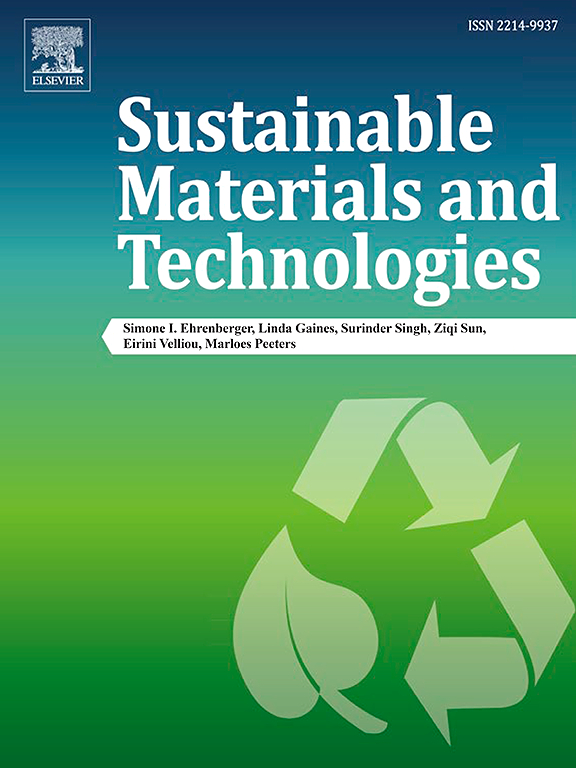IF 8.6
2区 工程技术
Q1 ENERGY & FUELS
引用次数: 0
摘要
海洋腐蚀是水下材料和结构面临的一个长期问题,腐蚀和生物污垢的相互关联需要新的方法来满足海洋资源日益增长的需求。在此,我们介绍了固定有 2-巯基苯并噻唑(MBT)腐蚀抑制剂的环境友好型壳聚糖涂层,该涂层具有针对海洋生物的防污特性,可提供积极的腐蚀保护。研究了壳聚糖和 MBT 之间的分子相互作用对耐腐蚀性和防污性能的影响。物理结合是通过 MBT 与壳聚糖-苯甲酮-3(CS-BP-3)共聚物之间的非共价π-π 堆积实现的,这提高了 MBT 的负载效率,并形成了更光滑的涂层。红外光谱分析首次证实了 MBT 与壳聚糖之间的化学连接。电化学测量结果表明,物理连接和化学连接两种策略都能显著提高缓蚀效果,其中化学连接涂层的耐腐蚀性明显更高。物理关联涂层的腐蚀电流比 MBT 嵌入涂层低一个量级,而化学连接形成的涂层则更好,约为物理关联涂层的五分之一。针对海洋贻贝(Mytilus coruscus)对这些涂层的防污活性进行了评估,化学连接的 CS-MBT 涂层在 48 小时后的沉降率为 10%,而物理连接涂层的沉降率为 20%。这项研究成果为构建有效抑制腐蚀并具有长期防污特性的涂层提供了一条新途径。本文章由计算机程序翻译,如有差异,请以英文原文为准。

Chemical linkage in bifunctional chitosan-mercaptobenzothiazole (MBT) coatings for enhanced corrosion prevention and antifouling activities
Marine corrosion is a longstanding issue for underwater materials and structures, where the interlinked challenges of corrosion and biofouling require new approaches to source increasing needs of the marine resources. Herein we introduce environment-friendly chitosan coatings immobilized with corrosion inhibitor of 2-mercaptobenzothiazole (MBT) for active corrosion protection with antifouling properties against marine organisms. The molecular interaction between chitosan and MBT on corrosion resistance and antifouling performance was studied with the coatings where MBT was entrapped, physically associated, or chemically linked to chitosan. The physical association is achieved by the non-covalent π-π stacking between MBT and chitosan-benzophenone-3 (CS-BP-3) copolymer, which improved loading efficiency of MBT and formed a smoother coating. For the first time, MBT was chemically linked to chitosan confirmed by infrared spectroscopy. Electrochemical measurements revealed that both physical association and chemical linkage strategies can enhance the corrosion inhibition dramatically, where the chemical linked coating has a significantly higher corrosion resistance. The corrosion current of the physically associated coatings is a magnitude lower than that of MBT-entrapped coatings, while the coatings formed by chemical linking is even better, about one fifth compared to physically associated coatings. Antifouling activity of these coatings were evaluated against marine mussels (Mytilus coruscus), where chemically linked CS-MBT coating exhibits 10 % settlement after 48 h, compared to 20 % settlement on coatings prepared by physical association. The findings in this work provide a new route to construct coatings that are effective in corrosion inhibition and have long-term antifouling properties.
求助全文
通过发布文献求助,成功后即可免费获取论文全文。
去求助
来源期刊

Sustainable Materials and Technologies
Energy-Renewable Energy, Sustainability and the Environment
CiteScore
13.40
自引率
4.20%
发文量
158
审稿时长
45 days
期刊介绍:
Sustainable Materials and Technologies (SM&T), an international, cross-disciplinary, fully open access journal published by Elsevier, focuses on original full-length research articles and reviews. It covers applied or fundamental science of nano-, micro-, meso-, and macro-scale aspects of materials and technologies for sustainable development. SM&T gives special attention to contributions that bridge the knowledge gap between materials and system designs.
 求助内容:
求助内容: 应助结果提醒方式:
应助结果提醒方式:


